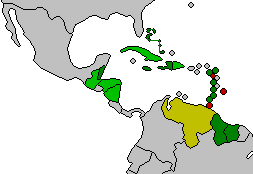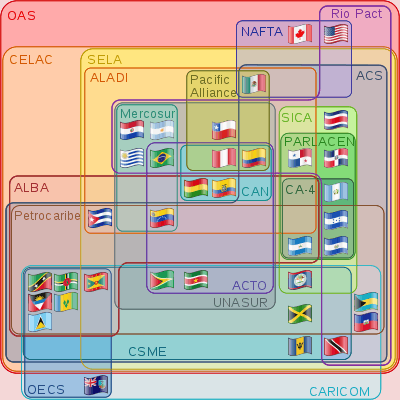Petrocaribe
Petrocaribe is an oil alliance involving 18 Caribbean member states. The alliance was founded on 29 June 2005 in Puerto La Cruz, Venezuela, Venezuela offering the other member states oil supplies based on a concessionary financial agreement. Petrocaribe has been part of the "pink tide" in Latin America seeking to achieve post-neoliberal development in the region.[1] In 2013 Petrocaribe established links with the Bolivarian Alliance for the Americas (ALBA) aiming to go beyond oil trade and promoting economic cooperation.[2]
| Public | |
| Industry | Oil |
| Founded | June 2005 |
| Headquarters | ? |
| Products | Oil |
| Revenue | |
| Parent | PDVSA |
| Website | www.petrocaribe.org |

Treaty details
The agreement was initiated with the aim of having solidarity with other countries in accordance with ALBA. The payment system allows for the purchase of oil at market value for 5%-50% up front with a grace period of one to two years; the remainder can be paid through a 17-25 year financing agreement with 1% interest if oil prices are above US$40 per barrel. The agreement builds on payment terms from the San Jose Agreement and the Caracas Energy Accord.[3][4] Energy and Petroleum Minister and President of PDVSA Rafael Ramírez said of the deal that it seeks to cut out the middleman in such transactions: "We're not talking about discounts...We're talking about financial facilities, direct deliveries of products, [and] infrastructure."[5]
Membership

There are a total of 17 members; 12 of the members are from the 15 member CARICOM (excluding Barbados, Montserrat, and Trinidad and Tobago). At the first summit, 14 countries joined the alliance; these were Antigua and Barbuda, the Bahamas, Belize, Cuba, Dominica, the Dominican Republic, Grenada, Guyana, Jamaica, Saint Lucia, Saint Kitts and Nevis, Saint Vincent and the Grenadines, Suriname, and Venezuela. At the third summit, Haiti and Nicaragua joined the union.[3] Guatemala joined in July 2008 but left the organization in November 2013 stating that Venezuela had not provided them with the ultra-low financing rates that they had been promised.[6]
Haiti had not been initially invited to the talks, since Venezuela did not recognize its then post-Jean-Bertrand Aristide government. However, Hugo Chavez actively "courted" newly elected president René Préval when he took office, much to Chevron, Exxon, and the US State Department's chagrin. After Venezuela had invested in developing Haitian infrastructure, and after the Haitian government convinced Chevron to deliver the oil from Venezuela, on 8 March 2008 the first shipment of oil was received.[7] Honduras became the 17th member of the alliance in December 2007, under President Manuel Zelaya but left the organization after the 2009 coup d'état before rejoining it on May 2012.[8] Belize set up the Belize Petroleum Energy Company to coordinate for the project.[9]
Non-members
Barbados denied that it had succumbed to pressure from the United States, who had a strained relationship with Venezuela, as the reason, but has not ruled out agreeing to Petrocaribe in the future. On August 31, 2005, Energy Minister Anthony Wood said that they are weighing options over signing Petrocaribe.[9] In April 2011 Venezuelan president Hugo Chávez renewed his offer for Barbados to join Petrocaribe.[10]
Panama applied for membership on 3 March 2009[11] and initially said it would continue to join Petrocaribe under the new president,[12] but Panama remains a non-member.
Summits
The first summit, which launched the project was held in Puerto La Cruz, Venezuela.[3] The second summit of Petrocaribe was held in Montego Bay, Jamaica.[9] The third summit was held in Caracas, Venezuela and the fourth summit was held in Cienfuegos, Cuba in December 2007.[3] The seventh summit was held in Caracas, on 6 April 2013. The membership of Honduras was revived after suspension because of the 2009 Honduran coup; Guatemala became an official new member of Petrocaribe. Summit also propose deeper cooperation between Petrocaribe states and states of ALBA on basis of new economic zone. Summit had discussion also about tourism, air traffic and food security. The 11th Summit was hosted by Haiti in Port-au-Prince.
See also
- SUCRE (currency)
- History of Venezuelan Oil Industry
- Petróleos de Venezuela, S.A.
Notes
- Cederlöf, Gustav; Kingsbury, Donald V. (2019). "On PetroCaribe: Petropolitics, Energopower, and Post-Neoliberal Development in the Caribbean Energy Region". Political Geography. 72: 124–133. doi:10.1016/j.polgeo.2019.04.006.
- Venezuelanalysis.com, 6 April 2013, Petrocaribe Meets in Venezuela, Links With ALBA
- http://www.pdvsa.com/index.php?tpl=interface.sp/design/readmenuprinc.tpl.html&newsid_obj_id=174&newsid_temas=48&prev=/search?q=PDVSA+PetroCaribe&hl=en&lr=&sa=G. Retrieved 26 August 2018. Missing or empty
|title=(help) - Cederlöf, Gustav; Kingsbury, Donald V. (2019). "On PetroCaribe: Petropolitics, Energopower, and Post-Neoliberal Development in the Caribbean Energy Region". Political Geography. 72: 124–133. doi:10.1016/j.polgeo.2019.04.006.
- "PetroCaribe: Chávez's Venturesome Solution to the Caribbean Oil Crisis". Venezuelananalysis.com. 31 January 2006. Retrieved 26 August 2018.
- "Archived copy". Archived from the original on 2013-12-10. Retrieved 2013-12-03.CS1 maint: archived copy as title (link)
- Kim Ives (7 June 2011). "How Washington and Big Oil Fought PetroCaribe in Haiti". Haïti Liberté. 4 (46). Retrieved 24 March 2019.
- "Oil Industry Professionals, Trading, Risk Management & Treasury, Settlement & Compliance - Platts". 4 June 2011. Archived from the original on 4 June 2011. Retrieved 26 August 2018.
- "BBCCaribbean.com - News - Barbados will not sign Petrocaribe". Bbc.co.uk. Retrieved 26 August 2018.
- "Chavez wants Barbados to sign PetroCaribe". Nationnews.com. Retrieved 26 August 2018.
- "Archived copy". Archived from the original on 2014-03-28. Retrieved 2014-03-28.CS1 maint: archived copy as title (link)
- "Archived copy". Archived from the original on 2014-03-28. Retrieved 2014-03-28.CS1 maint: archived copy as title (link)
External links
- Like Sucre in Ayacucho! - Speech by President Hugo Chávez to the 6th Petrocaribe Summit